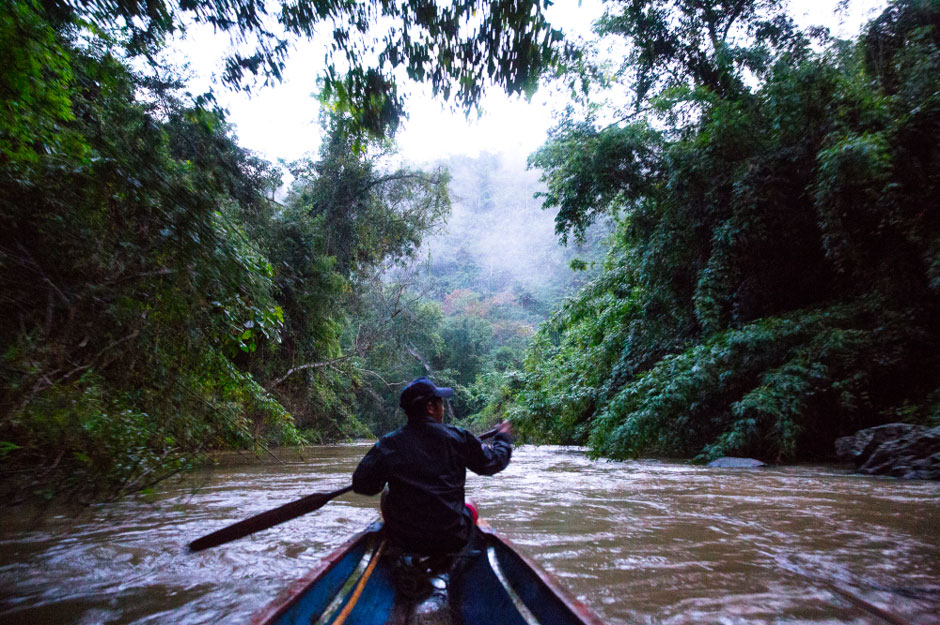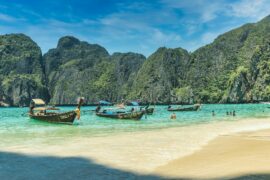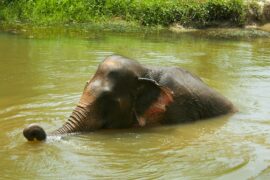Nam Et-Phou Louey National Park
Are you looking for ways to marry your travels with wildlife conservation? It’s perfectly possible at Nam Et-Phou Louey National Park (NEPL NP, for short).We interviewed Janina Bikova, Ecotourism Advisor at the Wildlife Conservation Society, to gain an insight into how the park and those working and living within it have built a flourishing operation that improves the lives of local and preserves the delicate ecosystem in one ingenious stroke.
To begin, how about a little background info on the park and the Wildlife Conservation Society?
Located in the north-east of Laos, the park is the largest protected area in the country. It’s unique in its biodiversity and supports a wide range of species – many of which are endangered. In the park you’ll find various species of wild cats, Dhole, Northern White-Cheeked Gibbons, bears, binturongs, otters, hornbills, civets, Phayre’s Langur and more. 30,000 villagers from more than a hundred communities live within or just outside the park, too. Many are from some of the poorest districts of Laos, where people are heavily dependent on natural resources.
The Wildlife Conservation Society has been supporting the Nam Et-Phou Louey National Park’s Management Unit since 2003, and has assisted with the development of ecotourism products from 2010. The park’s ecotours are one of the very few opportunities in Laos to view wildlife. They are designed to support alternative wildlife friendly livelihoods for local people, and to generate community support for wildlife conservation.

How are you working to create a link between tourism and wildlife conservation?
Ecotourism activities at Nam Et-Phou Louey have been created to provide livelihood opportunities for local people, and have been designed to create a direct link between conservation and tourism, so that the money generated by visitors acts as an incentive for local people to protect endangered wildlife.
So far, wildlife protection has been improved by getting the community actively involved, as well as creating financial incentives. Most ecotourism service providers are from former poacher households, now working as wildlife spotters and protectors, guides, boatmen, cooks and more. To spread the benefits of tourism fairly in the village, each participating household can have membership in only one service group position. More than 150 households from 4 different villages are involved in the National Park’s wildlife ecotours.

How do you encourage conservation among the local people?
To encourage conservation efforts, encounters with wildlife (including direct sightings and indirect observation like animal calls, footprints, and scat) by visitors on tours translate into financial bonuses not only for the individuals, but for the surrounding communities. Greater incentives are given for sightings of rarer species! All information collected on wildlife sightings and observations during the tours is recorded in a database, and is further incorporated into the National Park’s wildlife-monitoring program. 26 villages representing more than 2,000 households receive these incentives – almost 30% of all villages around the protected area, mostly Khmu and Hmong ethnic minority groups.
The primary aims of the park are:
- Create additional income for local people linked to wildlife conservation outcomes
- Generate sustainable financing for protected area management
- Increase awareness among local people and visitors about the importance of wildlife conservation.

Does the ecotourism program contribute to the park in other ways?
As well as supporting local livelihoods, the ecotourism program can also support a range of other conservation operations and objectives. For example, NEPL ecotourism contributes to the following National Park’s programmes:
- Wildlife Monitoring: data collection, recording, and reporting of statistics
- Natural Resource Protection and Law Enforcement:
- Ensuring regular and financially self-sustainable surveys of the protected area
- Identifying and communicating Illegal activities and
- Communicating protected area regulations to communities
- Education and Outreach. Provide knowledge to communities and visitors regarding:
- The importance of natural resource and wildlife conservation
- The local natural environment, culture and history
Wildlife tours
Keen to visit and experience the Laotian wilds for yourself? Below, Janina explains a couple of tour options available…

The Nam Nern Night Safari
Opened in 2010, the Nam Nern Night Safari is a stunning 24-hour boat-based wildlife spotting tour into the Nam Et-Phou Louey National Park. The highlight of the trip is the night-time wildlife spotlighting, taking place in a long-tail boat drifting down the Nam Nern River looking for wild and endangered animals. Guests can potentially spot Sambar Deer, multiple species of Civets, Spotted Linsang, Asian Golden Cats, Leopard Cats, Pythons and more. Day-time boat trips upstream the river offer opportunities for birdwatching too. Keep your eyes peeled for Blyth’s Kingfishers, Eared Pitta and Red-collared Woodpeckers.
In addition, visitors can follow the National Park’s guide on a short hike around the camp to learn about the history of the area, as well as to visit the nearby ranger substation. Visitors of the Night Safari stay overnight in jungle bungalows inside the National Park, built and managed by the community.
The Nam Nern Night Safari is a winner of the 2013 World Responsible Tourism Award “Best Responsible Wildlife Experience” and 2014 World Responsible Tourism Award for “People’s Choice for Responsible Tourism”. The year 2020 marks the 10 Year Anniversary for the Nam Nern Night Safari tour.

The Wildlife Conservation Trekking Tours
Following the success of the Night Safari, the Nam Et-Phou Louey National Park developed new wildlife conservation trekking tours in 2016. These 2 to 5 days treks offer a unique opportunity to enter one of the most important wildlife habitats of the National Park and to feel as field biologist for few days while tracking and identifying proof of wildlife along the trails.
Direct wildlife observations are rare on the trekking tours compared to the Night Safari tour, but if lucky visitors can spot various Civet species, Giant Flying Squirrels, Serow, Muntjacs, Sambar Deer, Macaques, and birdlife including Silver pheasants and Hornbills as well as hear the beautiful morning calls of the critically endangered Northern White-Cheeked Gibbons. Together with the National Park’s and village guide (former poacher) analyze the footprints, scratches, scat, and view camera trap images set along the trail and you might see the proof of presence of Clouded Leopard, Dhole or bears. The data from the camera traps is further incorporated into the national park’s wildlife-monitoring program.
If you love a challenge, you can even trek up to the summit of Phou Louey, the “Forever” Mountain (Elev. 2257m) – the highest point of the National Park and the third-highest peak in Laos!




